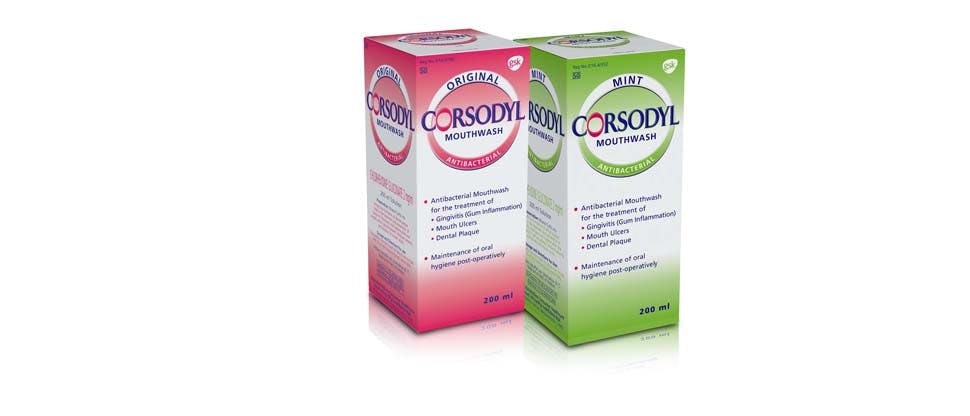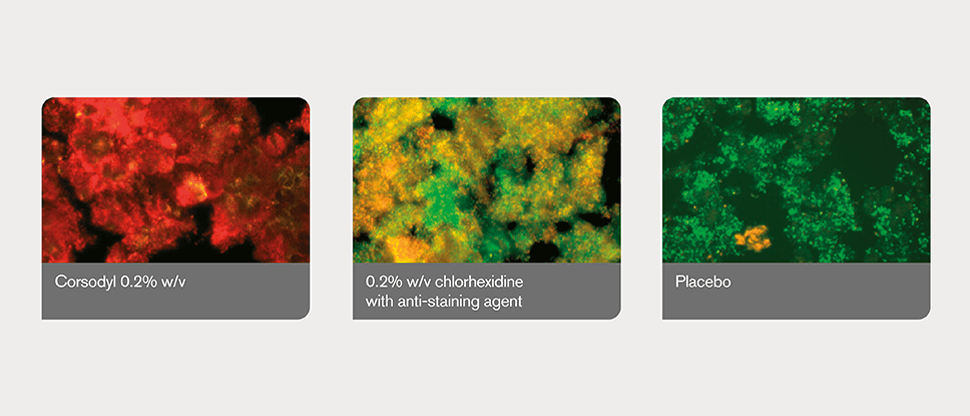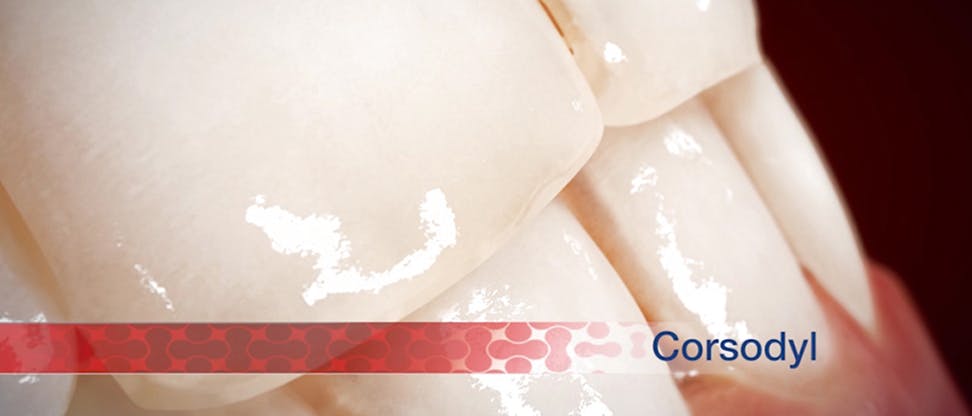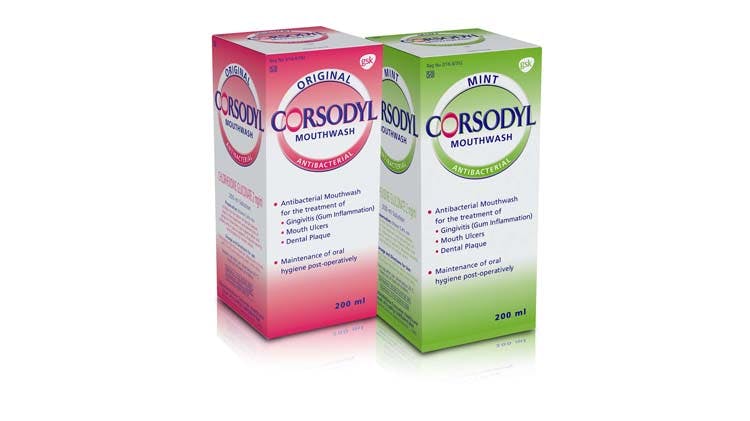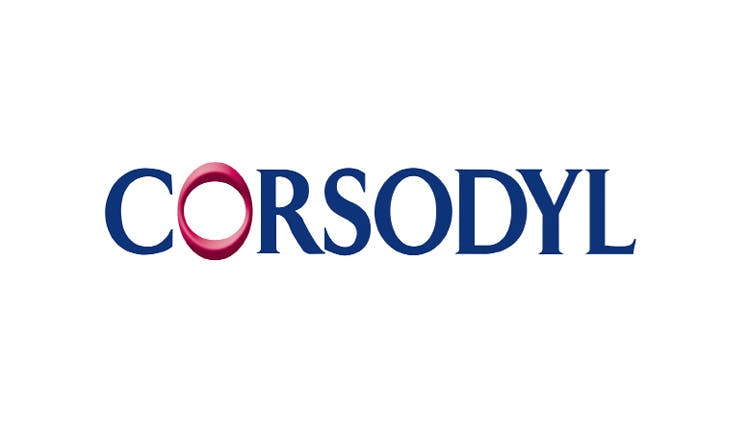SCHEDULING STATUS
S0
PROPRIETARY NAME (and dosage form)
Corsodyl Mouthwash Original (Solution)
Corsodyl Mouthwash Mint (Solution)
COMPOSITION
Active ingredients: Chlorhexidine gluconate 2 mg/ml,
Inactive ingredients: Corsodyl Mouthwash Original: anise oil, kolliphor RH 40, ethanol, peppermint oil, ponceau 4R (E 124; CI 16255) and purified water.
Sugar free.
Preservative: ethanol 5.4 % m/v
Corsodyl Mouthwash Mint
kolliphor RH 40, peppermint oil, purified water and sorbitol.
Contains sugar.
PHARMACOLOGICAL CLASSIFICATION:
A 16.4 Nasopharyngeal and buccopharyngeal antiseptics
PHARMACOLOGICAL ACTION:
Chlorhexidine is a bactericidal cationic antiseptic . It acts by destroying the cell membrane and precipitating the cell cytoplasm. It has been shown that chlorhexidine binds to the hydroxyapatite of tooth enamel, to the pellicle of the tooth surface and to salivary mucins. It slowly desorbs from these sites to exert a prolonged bactericidal effect for several hours.
INDICATIONS
Corsodyl Mouthwash is an antibacterial solution which inhibits the formation of dental plaque. It is indicated as an aid in the treatment and prevention of gingivitis,and in the maintenance of oral hygiene, particularly in situations where toothbrushing cannot be adequately employed(e.g. following periodontal and other oral surgery or in mentally or physically handicapped patients). It reduces the duration and severity of both aphthous ulceration and oral ulcers caused by mechanical or chemical injuries e.g. orthodontic appliances. It aids in management of recurrent oral candidal infections.
CONTRAINDICATIONS
Corsodyl Mouthwash is contraindicated on those patients who have known hypersensitivity to chlorhexidine gluconate or any of the ingredients in the product.
WARNINGS AND SPECIAL PRECAUTIONS
For oral use only. Do not swallow.
Keep out of the eyes and ears. In case of accidental contact with the eyes, wash out promptly and throroughly with water.
- Discolouration: A superficial yellow-brown discolouration of the dorsum of the tongue, of the teeth and on silicate or composite restorations may occur. The former disappears after treatment is discontinued; the latter can largely be prevented by brushing with conventional toothpaste, or in the case of dentures, cleaning with a proprietary denture cleanser. Where this is not possible as for example with intermaxillary fixation, or with extensive orthodontic appliances, a dental prophylaxis may be required once the underlying condition has resolved.
- Taste: Disturbances of taste sensation and numbness, tingling or burning sensation of the tongue may occur on initial use of Corsodyl Mouthwash. These effects usually diminish with continued use. If the condition persists, a doctor should be consulted.
- Oral Desquamation: Oral desquamation may occur when using Corsodyl Mouthwash. This may require dilution of the mouthwash(5 ml mouthwash with 5 ml tap water freshly mixed) and less vigourous rinsing, or discontinuation of the mouthwash.
- Parotid Gland Swelling: Swelling of the parotid glands during use of Corsodyl Mouthwash has been reported. In all cases spontaneous resolution has occurred on discontinuing treatment.
- Corsodyl Mouthwash is incompatible with the detergents in most toothpaste. If toothbrushing with conventional toothpaste is carried out in addition to Corsodyl Mouthwash, this should either be done before the use of Corsodyl Mouthwash, rinsing the mouth thoroughly between applications, or at a different time of day(see interactions)
Effects on ability to drive and use of machines:
Corsodyl Mouthwash has no or negligible influence on the ability to drive or the use of machinery.
INTERACTIONS
Clinically significant interactions with other medicines are not known. Corsodyl Mouthwash is incompatible with anionic agents e.g. sodium lauryl sulphate (See Warnings and Special Precautions).
HUMAN REPRODUCTION
Safety in pregnancy or lactation has not been established
DOSAGE AND DIRECTIONS FOR USE
- Use twice a day. The measuring cap on the bottle holds 10 ml when filled to the line. Thoroughly rinse the mouth for about one minute with 10 ml twice daily.
- Gingivitis: For the treatment of gingivitis, a course of about a month is advisable although some variation in response is to be expected.
- Oral Candidal infections: In the case of oral candidal infections, treatment should be continued 48 hours after clinical resolution.
- Denture Stomatitis: For the treatment of denture stomatitis, the dentures should be cleansed and soaked in the solution for 15 minutes twice daily.
- Children and Elderly: The recommended adult dose is appropriate for elderly patients and children of 12 years and over, unless otherwise recommended by the dentist or medical practitioner. Children under 12 years of age should not use this product.
SIDE EFFECTS
Side effects are generally minor and local in nature. The frequency of the following adverse events are unknown.
- Immune system disorders: Hypersensitivity and anaphylaxis(see Contraindications).
- Nervous system disorders: Transient taste disturbance, transient numbness, tingling or burning sensation of the tongue may occur on initial use(see Warnings and Special Precautions).
- Gastrointestinal disorders: Discolouration of the teeth and tongue, soreness/irritation of the mouth, desquamation/soreness/swelling of oral mucosa, parotid gland swelling(see Warnings and Special Precautions)
- In the case of soreness, swelling or irritation of the mouth, use of the product should be stopped and a dentist or doctor should be consulted.
KNOWN SYMPTOMS OF OVERDOSE AND PARTICULARS OF ITS TREATMENT
In the event of excessive systemic ingestion of Corsodyl Mouthwash, gastric lavage is indicated. Employ supportive measures as appropriate.
Due to the alcohol content in Corsodyl Mouthwash Original (5.4% m/v), ingestion of large amounts by children requires attention, seek medical advice for appropriate action.
IDENTIFICATION:
CORSODYL MOUTHWASH ORIGINAL: A clear pink mobile solution with an odour of peppermint and anise.
CORSODYL MOUTHWASH MINT: A clear or slightly opalescent colourless solution with an odour of peppermint.
PRESENTATION:
CORSODYL MOUTHWASH ORIGINAL:
200 ml glass and plastic bottle.
CORSODYL MOUTHWASH MINT:
300ml PET bottle: 300ml Amber color PET bottle with polypropylene plastic closure.
600ml PET bottle: 600ml Amber color PET bottle with Polypropylene plastic closure.
STORAGE INSTRUCTIONS:
Replace cap after use. Store at or below 25 °C.
Keep out of reach of children.
REGISTRATION NUMBERS:
CORSODYL ORIGINAL MOUTHWASH: S/16.4/182
CORSODYL MOUTHWASH MINT: Z/16.4/352
NAME AND BUSINESS ADDRESS OF THE HOLDER OF CERTIFICATE OF REGISTRATION:
GlaxoSmithKline Consumer Healthcare South Africa (Pty) Ltd
39 Hawkins Avenue
Epping lndustria 1
Cape Town, 7460
Reg. No: 2014/173930/07.
For full prescribing information refer to the professional information approved by the medicines regulatory authority. Always read the label before use.
For any further information, including safety, please contact the GSK Hotline on +27 11 745 6001 or 0800118274.
Trademarks are owned by or licensed to GSK group of companies.
DATE OF PUBLICATION OF THIS PACKAGE INSERT:
The date of registration of the medicine (CORSODYL MOUTHWASH ORIGINAL): 30 September 1992
The date of registration of the medicine (CORSODYL MOUTHWASH MINT): 25 August 1986.
Date of the most recent amendment to the professional information as approved by the Authority: 16 April 2015
